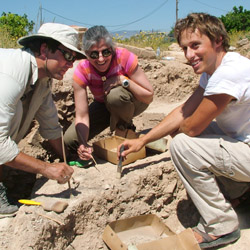Other Recent Excavations in Corinth
Excavations in the Frankish Area, 2014-2017
Excavations resumed in the Frankish Area from 2014 to 2017 with the goal to remove modern fill and finish excavating the area before opening for the public. Much of the effort is focused on the small church with a cloister on its north side. More evidence for its function as a cemetery church was found just north of the narthex due to additional graves just north of the narthex. Archaeologists discovered that some graves had been reused, with the bones of the original occupant moved but then later re-interred where they belonged. Since the first excavations of the Frankish Area in the 1990s, the burials have shown a wide range of fascinating (and often lethal) pathologies such as evidence for trepanning, bone cancers, death caused by complications during childbirth, and several individuals who suffered from Brucellosis (Meleteos). The monastery may well have had responsibilities for the care and treatment of the sick, old and infirm as well as women in labor. Watch osteologist Larkin Kennedy discuss how she processes and studies human remains. Thanks to the official count of 642 coins discovered in the 2015 season, there may soon be further evidence for the construction date of the Church in the Frankish area.

Frankish Area 2014
Excavations in the Nezi Field, 2007-2013
Excavations were active in the Nezi Field (named for the family who owned the land) from 2007-2013. The plot is located adjacent to the archaeological site, south of the South Stoa. Here, Henry Robinson revealed a complex of medieval houses in the early 1960s. During the first season in 2007, work concentrated on phasing the architectural remains using the old excavation notebooks and by careful excavation in critical places. A new area opened to the south of Mr. Robinson’s excavation was intended to reveal more buildings of his Byzantine phase. These structures were further explored to prepare them for final publication and conservation. Adjacent to this area and to the south, excavations began at topsoil in Nezi Field proper. Frankish, Byzantine, and Late Roman levels were investigated though the 2013 season. One of the most notable discoveries was the probable intersection of the Decumanus and the Lechaion Road.

Nezi Field Excavations
Excavations in the Panayia Field, 1995-2008
From 1995 to 2007, excavations were conducted in the Panayia Field, southeast of the Forum. While the Panayia Field has offered finds from all periods, Neolithic to early modern, the most exciting and extensive cultural horizons include a post-Greek War of Independence neighborhood, a 17th-18th century A.D. cemetery associated with the demolished Panayia church, a 6th century A.D. bath, a richly decorated Roman domus situated just outside the Roman Forum, a series of Hellenistic cellars/cisterns, and a Geometric cemetery. In 2007, excavations concluded in the Panayia Field, when colluvium from the Late Neolithic period was encountered over the entire extent of Panayia Field excavations opened to date. Unfortunately, further work in the field is impracticable without new storage facilities for human bone material because cemeteries from the Ottoman and Early Modern periods cover the north part of the field. Conservation work to stabilize baulks, walls, and mosaics began in spring 2007.

2007-8 Regular members with Ioulia Tzonou
